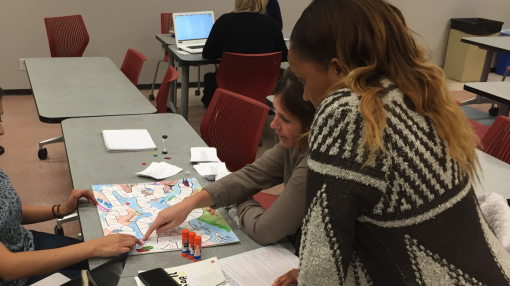On June 6, 2016 the Chronicle of Higher Education featured the founder of Peer Instruction and my mentor Eric Mazur in article titled “The Making of a Teaching Evangelist,” by Dan Berrett. 
The article describes the history of Peer Instruction and how Mazur’s defining pedagogical method led to his new course redesign approach. While the article describes a protocol for remaking any course from the ground up, I used Mazur’s redesign approach to create a brand new course. I added a few dabs of my own design DNA and have since taught the project-based learning course, Technology and Innovation in Higher Education, twice at The University of Texas at Austin.
One of Mazur’s philosophies that infuses everything I do as an educator is that people learn best when they are engaged. While the approach requires committing to careful rethinking of some of the most sacred features of a course, it leads to a much higher level of student and teacher engagement.
Here is the basic approach:
- Reimagine what students (and you) do before class: Mazur’s new method puts a premium on motivating and rewarding pre-class work. He uses an online platform called Perusall that he recently developed.
My design also heavily emphasizes the importance of pre-class work. I use Just-in-Time Teaching and Instructure’s Canvas to assign students pre-class “Warm-Ups.” I use this rubric to evaluate students’ pre-class engagement. Their score is based entirely on effort and counts for 10% of the final course grade.I had no problems with student engagement or completion of pre-class assignments, however one critique of my approach is that my design encourages pre-class work to be a solo enterprise. Mazur’s method promotes and rewards collaborative learning during pre-class activities not just in-class. - Rethink Exams and Lectures: Mazur does not hold traditional exams, rather he does five “Readiness Assurance Activities” drawn from the Immediate Feedback Assessment Technique featured in Team-Based Learning.I adopt a similar approach but call it a CO-LAB, a collaborative lab activity whereby I infuse retrieval practice into each class meeting. Students apply what they learned in their pre-class readings or activities on 10 assessment items that require to engage in deep, inferential thinking and transfer of learning based on concepts or ideas they read (in other words, no verbatim or softball questions).
Students answer the 10 questions on their own first and then move into pre-assigned, permanent teams to work together to answer the same set of questions with immediate feedback on correctness. Students get multiple chances to response with the answer correct during the teamwork portion, receiving less credit for a second, third, or fourth attempt. I use the team-based feature of Learning Catalytics (also developed by Mazur) to deliver CO-LABS. Fifty percent of a students’ grade is based on their performance on the individual portion and fifty percept on their team score. (This is kind of confusing, if you would like to learn more from me here and Learning Catalytics here and here.)
The only lecturing I did during class time during the entire semester was during an explanation phase at the end of each CO-LAB. Based on feedback research from Andy Butler, Namrata Gobble, and Elizabeth Marsh (2013), I always went through each item and provided short explanations. The CO-LABS are worth 20% of the final grade. This means 30% of students’ final grades are based on their engagement in pre-class work. Such a design sends a clear message on how important it is to engage pre-class and eliminated the need for me to lecture on content they could easily read or access online.
- Offer Authentic Projects: One thing the Chronicle article did not mention is that Mazur’s new course features project-based learning. For example, when his

Flute created by Mazur’s AP50 students
students study the physics of sound, instead of simply reading it about it, doing homework problems, and then taking an exam, they build their own musical instruments (see a flute they built to the left). I used a similar approach and designed the entire course around four team-based projects.
For their final project, my students are required to build a beta-version board game that could replace a three hour workshop on a topic of their choosing within the field of higher education. For example, one group of students (pictured below) developed a board game to replace the traditional introductory training for residential assistants. Students are required to incorporate a number of technology, innovation, and learning theories, concepts, and approaches into their game designs. In 15 years of practice in higher education at a variety of institutions, I have never seen deeper or more sincere engagement in the subject matter. Many times during a project, I tried to let class out early and I could not convince my students to leave!

My students working on their game project
Mazur has also redesigned the homework experience, which I have written about previously here. For those of us who teach seminars and do not have required problem sets, rethinking homework may play less of a necessary role in designing or redesigning a course to increase student engagement.
On reflecting on the Technology and Innovation course, one of my students said, “There is no way to be successful in this course and not be engaged. In some classes, if you are busy you can have a few off weeks or just load all the learning in the end. In Tech and Innovation, you cannot just show up sporadically. If you aren’t engaged it won’t be just detrimental to you, but other students as well.”

What do you think?